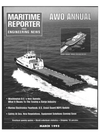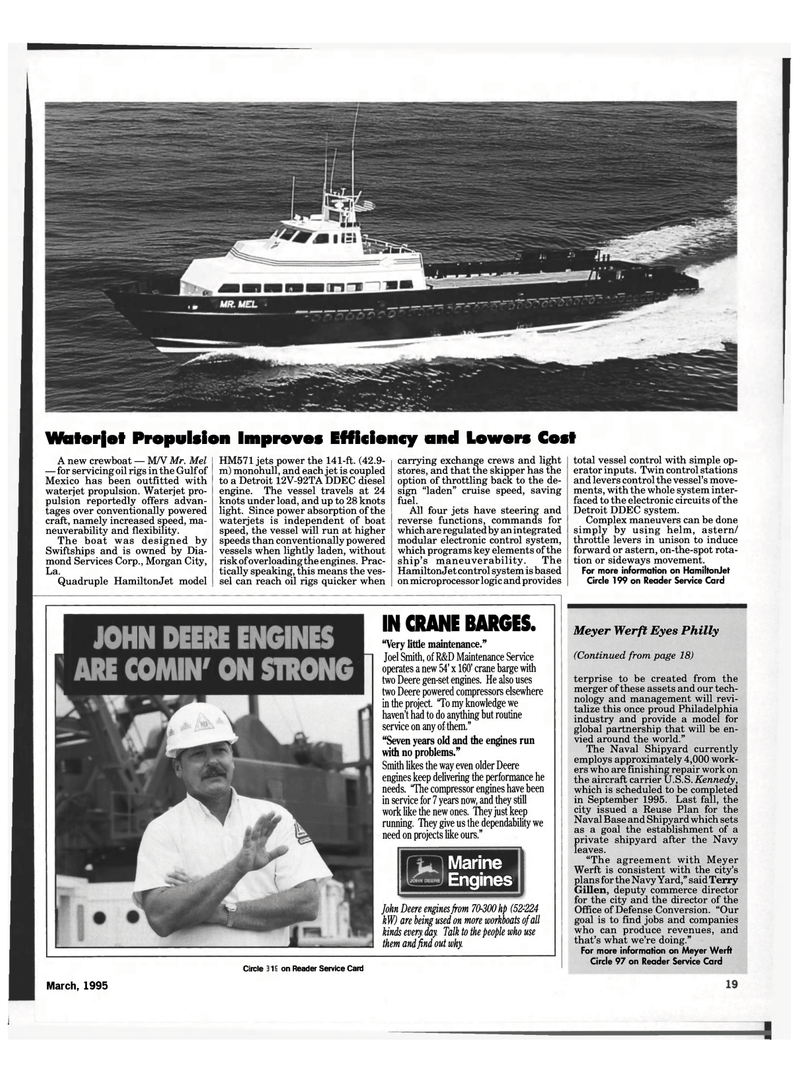
Page 17: of Maritime Reporter Magazine (March 1995)
Read this page in Pdf, Flash or Html5 edition of March 1995 Maritime Reporter Magazine
Waterjet Propulsion Improves Efficiency and Lowers Cost
A new crewboat — M/V Mr. Mel — for servicing oil rigs in the Gulf of
Mexico has been outfitted with waterjet propulsion. Waterjet pro- pulsion reportedly offers advan- tages over conventionally powered craft, namely increased speed, ma- neuverability and flexibility.
The boat was designed by
Swiftships and is owned by Dia- mond Services Corp., Morgan City,
La.
Quadruple HamiltonJet model
HM571 jets power the 141-ft. (42.9- m) monohull, and each jet is coupled to a Detroit 12V-92TA DDEC diesel engine. The vessel travels at 24 knots under load, and up to 28 knots light. Since power absorption of the waterjets is independent of boat speed, the vessel will run at higher speeds than conventionally powered vessels when lightly laden, without risk of overloading the engines. Prac- tically speaking, this means the ves- sel can reach oil rigs quicker when carrying exchange crews and light stores, and that the skipper has the option of throttling back to the de- sign "laden" cruise speed, saving fuel.
All four jets have steering and reverse functions, commands for which are regulated by an integrated modular electronic control system, which programs key elements of the ship's maneuverability. The
HamiltonJet control system is based on microprocessor logic and provides total vessel control with simple op- erator inputs. Twin control stations and levers control the vessel's move- ments, with the whole system inter- faced to the electronic circuits of the
Detroit DDEC system.
Complex maneuvers can be done simply by using helm, astern/ throttle levers in unison to induce forward or astern, on-the-spot rota- tion or sideways movement.
For more information on HamiltonJet
Circle 199 on Reader Service Card
Marine
Engines
Meyer Werft Eyes Philly (Continued, from page 18) terprise to be created from the merger of these assets and our tech- nology and management will revi- talize this once proud Philadelphia industry and provide a model for global partnership that will be en- vied around the world."
The Naval Shipyard currently employs approximately 4,000 work- ers who are finishing repair work on the aircraft carrier U.S.S. Kennedy, which is scheduled to be completed in September 1995. Last fall, the city issued a Reuse Plan for the
Naval Base and Shipyard which sets as a goal the establishment of a private shipyard after the Navy leaves. "The agreement with Meyer
Werft is consistent with the city's plans for the Navy Yard," said Terry
Gillen, deputy commerce director for the city and the director of the
Office of Defense Conversion. "Our goal is to find jobs and companies who can produce revenues, and that's what we're doing."
For more information on Meyer Werft
Circle 97 on Reader Service Card
IN CRANE BARGES. "Very little maintenance."
Joel Smith, of R&D Maintenance Service operates a new 54' x 160' crane barge with two Deere gen-set engines. He also uses two Deere powered compressors elsewhere in the project. 'To my knowledge we haven't had to do anything but routine service on any of them." "Seven years old and the engines run with no problems."
Smith likes the way even older Deere engines keep delivering the performance he needs. "Hie compressor engines have been in service for 7 years now, and they still work like the new ones. They just keep running. They give us the dependability we need on projects like ours."
John Deere engines from 70-300 hp (52-224 kW) are being used on more workboats of all kinds every day. Talk to the people who use them and find out why.
Circle 215 on Reader Service Card
March, 1995 85

 16
16

 18
18
